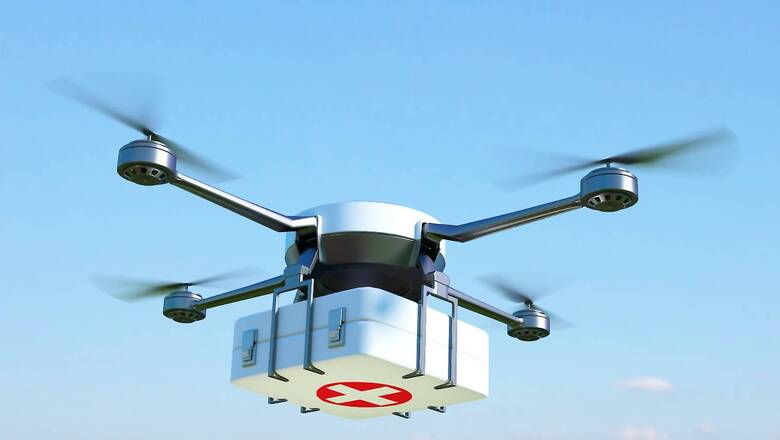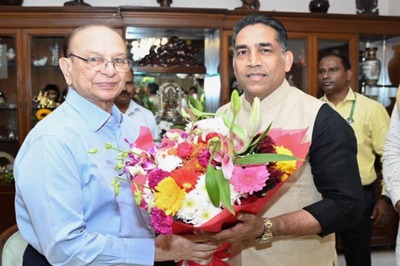
views
What information technology was in the 90s, drone technology is today. In fact, the drone will become part and parcel of our lives in the decades to come. The next generation probably will be born into a ‘Drone Age’. Posterity could look back at this shift as we look back at the ‘Stone Age, ‘Bronze Age’, and the ‘Iron Age’. Humans would be travelling, within cities, between one high-rise to another, or between two satellite towns on a drone. The drone could well become your vehicle and could well end up replacing surface transports like the car or a bus.
I say this with utmost responsibility because the amount of fuel that a drone burns is much more minor than the amount of fossil fuel that any mode of surface transport burns. Short-haul logistics, a connection between a hub to a micro hub in the logistic chain, including the food supply chain, and last-mile connectivity will be achieved using drones. Roads will be de-congested; humanity will reduce carbon emissions and leave a better world for the future. All, thanks to drones.
Also Read: Airport to Home in 10 Minutes in an ‘Uberdrone’: How Drones Will Change the Game
Therefore, to stay ahead of the game, countries need to invest in allied technologies that propel themselves in this direction called ‘The Drone world’ to make this a reality. Let’s look at those technologies that a nation needs to invest in, to surge ahead of its competitors.
Powertrain technology – BLDC
The Powertrain of a drone consists of a motor and a controller, which drives this motor differentially, depending on the demands of the flight controller. The motor could be further sub-divided into fossil fuel-driven, hydrogen fuel-driven or electric-driven motor. The most popular powertrain is an electric driven motor AKA Brushless Direct Current Motor popularly called a BLDC motor.
These brushless DC motors are primarily being imported from China, Taiwan, Singapore, and the USA. The fact of the matter is, that most of these motors are manufactured in China. Why China? Because they control the majority of the rare earths required to manufacture the magnet inside this motor called the neodymium magnet. As the world’s dependence on this motor grows, China will inflate its price, and we could see China making considerable profits in the times to come when the BLDC motor comes in short supply. We already see the signs of the same. There is another reason ‘Why China’? For these motors to function efficiently, it takes a certain kind of engineering. That kind of engineering requires machinery which would produce powertrains with an efficiency of over 80 to 90%. Apparently and obviously China has invested heavily in such machinery and technology.
Therefore, making the BLDC motor indigenously should be our number one priority. We need to make these motors in various sizes to suit all kinds of needs. Drones manufacturing will automatically follow suit.
Powertrain technology: Fuel-run motor
In applications where you need higher energy, like a cargo drone, agriculture drone, and so on, a fossil fuel-driven or hydrogen fuel-driven motor could become a viable option. It is in this area that China does not have a monopoly. This is where the real money lies, where India needs to concentrate. If we solve the powertrain, we will solve the issue of manufacturing drones in the future. Currently, hydrogen fuel-run motors are a work in progress, and fossil fuel-run motors are imported from China or Germany / USA. India has excellent capability in manufacturing engines of various sizes to suit multiple needs. From the 60s to early 2000, I remember we had a company in Kolkata that used to manufacture tiny engines, which was a big hit in the USA and London. Lack of demand, I remember, forced the company to shut down. We need to seriously look at this powertrain if we want to be a leader in drone technology in times to come.
Powertrain technology – Electronics
Electronics form a significant technology in the powertrain. This piece of powertrain electronics that I am talking about is called an ‘Electronic Speed Controller’, aka ESC. This particular PCB with a chip controls the speed of the motor as per the demand generated by the flight controller. This technology is not very complicated, and I believe companies in India have ventured into making ESC at home. However, up until today, all ESCs are being imported.
Flight Controller
This is one area where some companies have made headway and achieved a certain degree of indigenisation. Here too, companies are plagued by the availability of computer chips. Believe it or not, even those companies that have managed to indigenise the flight controller are importing sensors from abroad. This is fine as long as those companies that make sensors do not use the growing demand as an opportunity and monopolise the market in terms of supply and cost.
Horses to courses
Currently, most drone companies are rolling out drones following a philosophy of one size fits all. What I mean by this is that a particular organisation needs a drone that could operate at 20,000 feet and can take off and land vertically; we have very few companies that can fulfil that need.
R&D, therefore, has taken a backseat. Often, drone companies follow a philosophy of making minor changes to existing technology and giving a visual appeal rather than concentrating on performance enhancement.
Application of aerodynamic principles and keeping efficiency at the forefront should be the company’s prime focus in designing drones.
Battery Technology
Lithium-based batteries have been ruling the roost for the simple reason that it packs more energy per gram. I would go to the extent of saying that it is this breakthrough that pushed the boundaries where a piece of equipment could get airborne vertically carrying the battery, the airframe and a specific payload like a camera. China dominates the world’s lithium deposits. No surprise there, however in modern times, we see many new battery technologies are being experimented such as Zinc-manganese oxide batteries and gold nanowire gel electrolyte batteries which are non-lithium-based. Adequate research needs to develop battery technology for the world to go electric sooner than later.
Datalink Technology
For many years, drone command and the video downlink between the drone and the controller was happening on frequencies that did not have much of a range nor had that kind of throughout to push that kind of data that needs to be made. FHSS (frequency hopping spread spectrum) and multiplexing have changed today’s way of datalink. Today, Canada controls high-end drone data link technology, and China owns the lower-end drone datalink tech. Many Indian companies are working on this front. However, what they’re not able to achieve is low cost. They cannot provide drone companies with good datalinks at a competitive price. This is a big downside, and hopefully, as the demand increases, these companies too will come up with data that could be as cost-effective as what is out there in the market and reliable at the same time.
Making Bandwidth available for civilian use
Today, most of the data links work on open frequencies such as 2.4 GHz and 5.8 GHz. This spectrum is completely clogged because most of the modern Wi-Fi Bluetooth, name any– all equipment works in this frequency band. The Ministry of Communications needs to allocate unused military frequency bands for civilian use to de-clog the frequencies mentioned above and create data links that harness the bandwidth of these cleared frequencies. This effort cannot be unilateral by a single country; ITU (International Telecommunication Union), too, needs to come on board and de-clog specific frequencies for civilian use worldwide.
Also Read: After Abu Dhabi, Is Dubai Next? Why Drones Have Become Weapon of Choice for Terror Attacks
We are in a phase where companies are rolling out drones by the dozen, trying to cash in on the newfound limelight that these drones provide. Companies with a vision and countries with a vision will be investing not only in the drones but in the technology that will enable drones to be manufactured cost-effectively and become world leaders at the same time in the drone ecosystem. Let’s face one fact, most drone companies today are nothing more than the buy-stuff-and-assemble kind. If the drone ecosystem needs to improve, it can only improve if we invest in the future and not the present.
The author is Group Captain (retd), Fighter Pilot, MiG-21, Mirage-2000. He is DGCA-nominated Qualified Flying Instructor and Aircraft Accident Investigator. The views expressed in this article are those of the author and do not represent the stand of this publication.
Read all the Latest Opinion News and Breaking News here




















Comments
0 comment